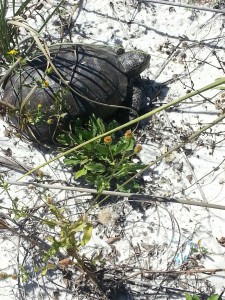
This gopher tortoise was found in the dune fields on a barrier island – an area where they were once found.
Photo: DJ Zemenick
The state of Florida has designated Sunday April 10 as “Gopher Tortoise Day”. The objective is to bring awareness to this declining species and, hopefully, an interest in protecting it.
During his travels across the southeast in the late 18th century, William Bartram mentioned this creature several times. As he walked through miles of open longleaf pine he would climb sand hills where he often encountered the tortoise. These turtles do like high dry sandy habitats. Here they dig their famous burrows into the earth.
These burrows can extend almost 10 feet vertically below the surface but, being excavated at an angle, can extend 20 feet in length. There is only one entrance and the tortoise works hard to maintain it. Field biologists have been able to identify over 370 species of upland creatures that utilize these burrows as refuge either for short or long periods of time. These include the declining diamondback rattlesnakes, gopher frogs, and the endangered indigo snakes, but most are insects and small mammals. Because of the importance of the burrows to these species, gopher tortoises are listed as keystone species – meaning their decline will trigger the decline of the others and can upset the balance of the ecosystem. Gopher burrows can be distinguished from mammal burrows in that they are domed across the top but flat along the bottom, as opposed to being oval. The width of the burrow is close to the length of the tortoise. When danger is encountered the tortoise will turn sideways – effectively blocking the entire entrance. Though there are cases of multiple tortoises in one, the general rule is one tortoise per burrow.
Tortoises are herbivores, feeding on a variety of young herbaceous shoots, and fruit when they can get find them. Fire is important to the longleaf system and it is important to the gophers as well. Fires encourage new young shoots to sprout. If an area does not receive sufficient fire, and the ground vegetation allowed grow larger with tougher leaves, the tortoise will abandon their burrow and seek more suitable habitat – which, especially in Florida – is becoming harder and harder to find. They typically breed in the fall and will lay their 5-10 eggs in the loose sand near the entrance of the burrow in spring. In August the hatchlings emerge and may hide beneath leaf litter, but will quickly begin their own burrows.
This tortoise is only found in the southeast of the United States and it is in decline across the region. They are currently listed as threatened in Florida but are federally protected in Louisiana, Mississippi, and western Alabama. They are found across our state as far south as the Everglades. There are several reasons why their numbers have declined. Human consumption was common in the early parts of the 20th century, and still is in some locations – though illegal. Some would, at times, pour gasoline down the burrow to capture rattlesnakes – this of course did not fare well for the tortoise. A big problem is the loss of suitable habitat. Much of upland systems require periodic fires to maintain the reproductive cycle of community members. The suppression of fire has caused the decline of many species in our state including gopher tortoises. These under maintained forest have forced tortoises to roadsides, power line fields, airports, and pastures. In each case they have encountered humans with cars, lawn mowers, and heavy equipment. Keep in mind also that our growing population is forcing us to clear much of these upland habitats for developments where clearing has caused the burial (entombment) of many burrows.
This is a unique turtle to our region and honestly, is a pleasure to see. We hope you will take the time to learn more about them by visiting FWC’s Gopher Tortoise Day website, enjoy watching them if they live near you, and help us conserve this species for future generations.
- Tips for Bear Encounters this Fall - November 10, 2025
- Pensacola Bay Invasive Species Summer Survey 2025 - November 3, 2025
- Our Environment: Part 24 – Our Changing Climate - November 3, 2025
